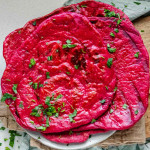Beetroot Flatbread
This beetroot flatbread is made with roasted beets for a beautiful pink color and earthy flavor. Perfect for wraps, dips, or as a base for mini pizzas.Prep Time allows time for roasting beets. If you already have roasted beets, the prep will be an hour quicker.
Servings: 6
Calories: 289kcal
Ingredients
- ¾ cups beetroot puree from about 3 roasted beets
- ¼ cup plain Greek yogurt
- 2 tablespoons olive oil divided
- ½ teaspoon salt
- 1 teaspoon instant yeast
- ½ cup warm water
- 3 cups all-purpose flour
Instructions
To roast the beets
- Scrub the beets and cut off the tops.
- Coat in olive oil and sprinkle with salt and pepper.
- Wrap each beet in foil or wrap two together.
- Place them on a baking sheet and bake at 400°F for an hour, until they are soft.
- Let the beets cool until you can handle them. Peel the skin off and slice them.
To make the flatbread
- Puree enough beets for 3/4 cup of puree. For me, these were three smallish beets.
- In a large mixing bowl, combine the beet puree, Greek yogurt, olive oil, and salt. Add the yeast to warm water (to help it mix well with the other wet ingredients - instant yeast does not need to be proofed in warm water). Mix well with a whisk.
- Add the flour and bring the dough together. I use a large spatula. Note: I add only most of the flour and mix that in first to prevent a dry dough. I show a step-by-step photo of what the dough looks like when it's too wet. Add the rest of the flour as needed and mix it in. The dough will be slightly tacky, but it should not stick to your hands.
- Add oil to the dough, which also helps it not to stick, and cover the bowl with plastic wrap and a towel. Let sit in a warm place for about 30 minutes or until the dough has about doubled in size.
- Press the dough into a flat disc and divide it into 6 mostly even pieces. Roll each piece into a ball and then roll it flat on a lightly floured countertop with a rolling pin.
- Brush off any extra flour, which will burn in the frying pan.
- Heat a large frying pan over medium heat but don't add oil. Add the flatbread one at a time, cooking for 4-5 minutes per side.
- Repeat for each flatbread.
- Brush with oil, ghee, or garlic butter and stack the flatbread together. I cover them with plastic wrap and a towel.
Video
Notes
Make sure to add enough flour. The dough will be a little bit tacky but it shouldn't stick to your hands.
Brush off the excess flour before cooking the flatbread for better flavor and less burning. After cooking a few, the dry excess flour will start to burn. You can also quickly and carefully wipe out the dry frying pan after each flatbread.
Use a kitchen scale to weigh the flour (360 grams/3 cups) to avoid overly dry or wet dough. That being said, all kitchen environments are different so you may need to add more flour a little at a time to achieve a dough that is tacky but not sticky. The step-by-step photos above show what the dough looks like when it's too wet and when it's correct.
Storage: These flatbreads are best on the day you make them when they are fresh and soft. Keep leftovers wrapped well so they don't dry out. Once the wraps dry out they get kind of chewy and not as easy to eat.
Nutrition
Calories: 289kcal | Carbohydrates: 51g | Protein: 8g | Fat: 6g | Fiber: 3g | Sugar: 2g | Calcium: 23mg | Iron: 3mg
